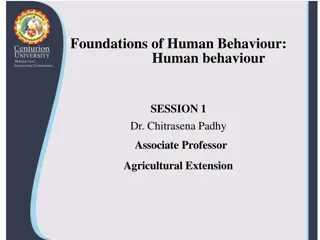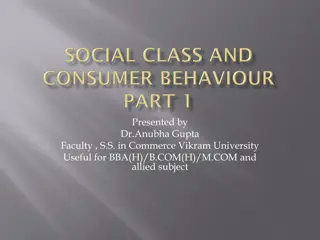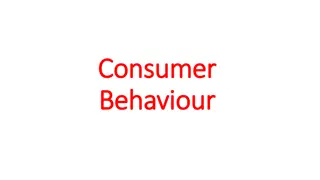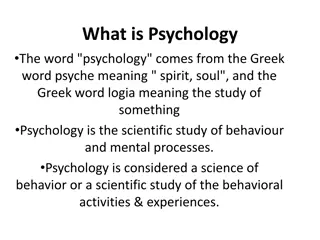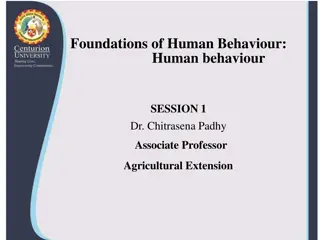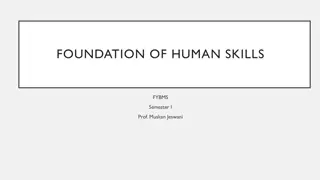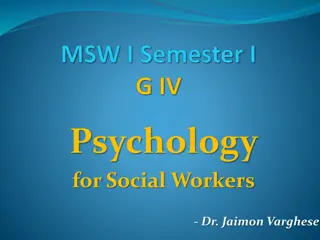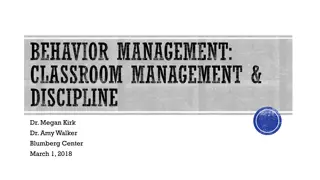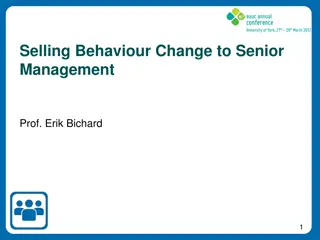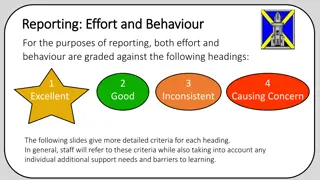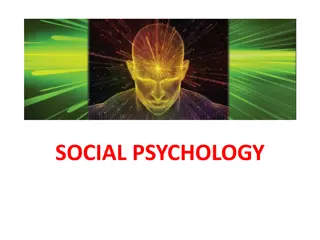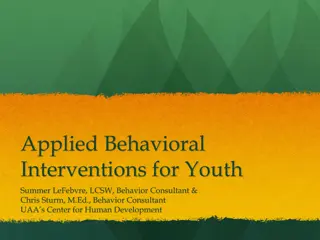
Understanding Behavior and Its Impact on Health
Explore the concept of behavior, its components, and determinants, and the significance of healthy vs. unhealthy behaviors in promoting or harming public health. Delve into the cognitive, affective, and psychomotor domains of behavior to understand its complexity and relevance in public health concerns.
Download Presentation

Please find below an Image/Link to download the presentation.
The content on the website is provided AS IS for your information and personal use only. It may not be sold, licensed, or shared on other websites without obtaining consent from the author. If you encounter any issues during the download, it is possible that the publisher has removed the file from their server.
You are allowed to download the files provided on this website for personal or commercial use, subject to the condition that they are used lawfully. All files are the property of their respective owners.
The content on the website is provided AS IS for your information and personal use only. It may not be sold, licensed, or shared on other websites without obtaining consent from the author.
E N D
Presentation Transcript
Health and Human Behavior BY: DEREJE GELETA (BSC, MPH)
Learning Objective At the end of this session; students will be able to: - Recognize the concept of Behavior - Lists the components of behaviour - List down the Determinants of human behaviors 2 BY: DEREJE G (BSC,MPH), HU
Behaviour Behavior- is an actionthat has specific frequency,duration, and purpose, whether conscious or unconscious. It is both the act and the way we act. Action types of overt behavior, such as Hand washing, Exercise, diet, ANC follow Up, Health Seeking, drinking, smoking, chat chewing, etc To say a person has Physical exercise behavior Duration it is the time spent since the action started or noticed such as for a week/months (it for a week/month) Frequency- how it is repeated in a certain period of time. Purpose is he/she doing consciously or not 3 BY: DEREJE G (BSC,MPH), HU
Components of Behaviour Components of Behaviour Basically our behavior has 3 domains A) Cognitive domain- stored information Encodes, stores, retrieves, processes information; purpose is manipulation of information Knowledge Perception Thinking 4 BY: DEREJE G (BSC,MPH), HU
Cont. B) Affective domain-cognition +feeling Attitude Beliefs Value purpose is to create arousal C) Psychomotor domain Psycho-mind Motor action 5 BY: DEREJE G (BSC,MPH), HU
Behavior and Health 1. Healthy behavior : can promote health E.g. Physical exercise, BF, seeking treatment 2. Ill/unhealthy behavior : can harm health Smoking, chat chewing, excessive alcohol consumption, unsafe sex, sedentary life style etc. 6 BY: DEREJE G (BSC,MPH), HU
Why Dealing With Human Behaviour Is Why Dealing With Human Behaviour Is Concern Of Public Health?? Concern Of Public Health?? The world is experiencing shift in cause of ill- Health: Behavior Bacteria 7 3/21/2025 BY: DEREJE G (BSC,MPH)
Cont Risk factors: traditional risk to modern risk 8 3/21/2025 BY: DEREJE G (BSC,MPH)
Cont. Disease burden: Communicable disease to non- communicable double burden (for developing countries) Human behaviors plays significant role as a cause as well as a solutions for existing and emerging problems 9 BY: DEREJE G (BSC,MPH), HU
Factors Determines Human Behavior There are three categories of factors affecting (determining) individual or collective behavior, each of which has a different type of influence on behavior: A. predisposing factor B. Enabling factors C. Reinforcing factors 10 BY: DEREJE G (BSC,MPH), HU
1.Predisposing factors Are antecedents or prior to behavior that provide the rationale or motivation for the behavior to occur. E.g. Knowledge, Perception, Belief , Attitude, Values etc. They are generally referred to cognitive variables because they are inside the mind inside head factors and have to do with knowing or believing 11 3/21/2025 BY: DEREJE G (BSC,MPH)
1. Knowledge 1. Knowledge Knowledge is necessary but not sufficient in behavior change. It is necessary, because, without adequate knowledge , people may unaware of and concerned about health problem and unable to manage their behavior. 12 BY: DEREJE G (BSC,MPH), HU
2. Attitude Attitude Social psychologists define an attitude as Social psychologists define an attitude as an enduring evaluation, positive or negative, of people, objects, or ideas. We are not neutral observers of the world; we evaluate what we encounter. Attitudes are often a matter of good or bad; as soon as you know what something is, you start to know whether you like it or dislike it. 13 BY: DEREJE G (BSC,MPH), HU
3. Belief Beliefs are what one perceive as a true, it may be correct or not. It also refers to a conviction that a phenomenon or object is true or real. It is different from knowledge in that it is perceived whereas knowledge is accepted as objective truth. 14 BY: DEREJE G (BSC,MPH), HU
Cont Beliefs are derived from parents, grand parents, and other people we respect to listen and are accepted as true. But we accept beliefs without trying to prove that they are true or false. 15 BY: DEREJE G (BSC,MPH), HU
Difficulty index of changing beliefs It is usually difficult to change those beliefs that are held by the whole community Have been deep rooted in the culture Come from highly respected and trusted sources Are part of the a religion or traditional medical system 16 BY: DEREJE G (BSC,MPH), HU
Cont It is usually easier to influence those beliefs that: are held by individuals have been acquired recently come from not highly respected sources are not part of religion or traditional medical system 17 BY: DEREJE G (BSC,MPH), HU
Types of Beliefs Harmful belief: is a belief which damage health. Helpful beliefs: is a belief which preserves health. Neutral beliefs: is a belief which neither damages nor preserves health. What do you if you are unsure??? 18 BY: DEREJE G (BSC,MPH), HU
4 4. VALUE . VALUE The relative preference/judgment individual gives every thing around is known as value. value is something is held to be important or worth; and prized by an individuals or community. 19 BY: DEREJE G (BSC,MPH), HU
Value conflict and value clarification People value life, i.e. health. However, in opposite engaged in unhealthy behavior, for instance, smoking. This reveals conflict of values=inconsistencies between two or more values. In health education one shouldn t seek to change values rather should help people recognizeinconsistencies between and among their values. We, often trying to encourage people to think about their values. This process is called value-clarification 3/21/2025 DEREJE G. (BSC,MPH)
Difficult index; Relationship between Attitude and Value Values are more permanent and resistant to change than attitudes and beliefs and they determine attitude. In terms of difficulty of changing: < < < Knowledge Beliefs Attitude Value 21 BY: DEREJE G (BSC,MPH), HU
2. Enabling Factors Enabling factors are those antecedents to behavior that facilitate a motivation to be realized. They help individuals to choose, decide and adopt behaviors and may be barriers and assets to needed changes. The absence of enabling conditions inhibits action/s 22 BY: DEREJE G (BSC,MPH), HU
Cont Enabling factors are those skills, resources, barriers that can help or hinder the desired behavioral changes as well as environmental changes. The health-care environment -availability -accessibility -affordability New skills: different skills Resources. E.g.. Facilities, money, time, labor services, skills, transportation, materials and the distribution and their location. 23 BY: DEREJE G (BSC,MPH), HU
3. Reinforcing Factors Reinforcing factors are those factors subsequent to a behavior that provide the continuing reward or incentives for the behavior to be persistentand repeated. Are those consequences of actions that determine whether the actor receives positive or negative feedback and is supported socially or by significant others after it occur/s. 24 BY: DEREJE G (BSC,MPH), HU
Cont Among these important people are elders, friends, peers, parents, grand parents, village leaders, religious leaders and people with a lot of experience and skills (teachers, health workers, etc.). Examples The woman does not adopt FP because her husband disapproves. The young man who starts smoking because his friends encourage him to do so 25 BY: DEREJE G (BSC,MPH), HU
Summary of factors affect human behaviors Predisposing factors create intention to act Realizes the intentions Enabling factors Encourage behaviors to persist Reinforcing factors Sustainable behavior Remember: Any given behavior can be explained as a function of the collective influence of these three factors 26 BY: DEREJE G (BSC,MPH), HU
Theoretical sequence to address determinants of behaviors Theoretical sequence to address determinants of behaviors Enabling factors Knowledge, attitude, beliefs, values Peer influence & social pressure Behaviors Availability, affordability, accessibility & others resources Reinforcing Reinforcing factors factors Predisposing factors In practice simultaneously In practice simultaneously 27 BY: DEREJE G (BSC,MPH), HU
Educational approaches to behavior change Determinants of behaviors Approaches to change Direct communication with target individuals- educational approaches Predisposing factors Organization change, avail services, accessibility, advocacy , resource mobilization Enabling factors In direct communication with the social environments , influential peoples Reinforcing factors 28 BY: DEREJE G (BSC,MPH), HU
Some reference materials 1. Lawrence W. Green et al. 1980. Health education planning a diagnostic approach 2. Randall R. Cottrell, James T. Girvan, James F. McKenzie 2006. Principles& foundations of health promotion and education. Third ed. USA. 3. BruceG, Wlter H, Nell H. Introduction to Health education and Health promotion;2nd edition, 1984 Ramachandran L. and Dharmalingam. T. 1995. Health education s new approach. 4. 29 BY: DEREJE G (BSC,MPH), HU
The End THANK YOU !! 30 BY: DEREJE G (BSC,MPH), HU




